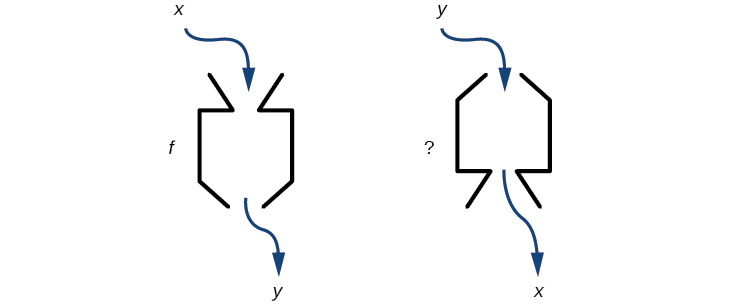| << Chapter < Page | Chapter >> Page > |
A reversible heat pump is a climate-control system that is an air conditioner and a heater in a single device. Operated in one direction, it pumps heat out of a house to provide cooling. Operating in reverse, it pumps heat into the building from the outside, even in cool weather, to provide heating. As a heater, a heat pump is several times more efficient than conventional electrical resistance heating.
If some physical machines can run in two directions, we might ask whether some of the function “machines” we have been studying can also run backwards. [link] provides a visual representation of this question. In this section, we will consider the reverse nature of functions.

Suppose a fashion designer traveling to Milan for a fashion show wants to know what the temperature will be. He is not familiar with the Celsius scale. To get an idea of how temperature measurements are related, he asks his assistant, Betty, to convert 75 degrees Fahrenheit to degrees Celsius. She finds the formula
and substitutes 75 for to calculate
Knowing that a comfortable 75 degrees Fahrenheit is about 24 degrees Celsius, he sends his assistant the week’s weather forecast from [link] for Milan, and asks her to convert all of the temperatures to degrees Fahrenheit.

At first, Betty considers using the formula she has already found to complete the conversions. After all, she knows her algebra, and can easily solve the equation for after substituting a value for For example, to convert 26 degrees Celsius, she could write
After considering this option for a moment, however, she realizes that solving the equation for each of the temperatures will be awfully tedious. She realizes that since evaluation is easier than solving, it would be much more convenient to have a different formula, one that takes the Celsius temperature and outputs the Fahrenheit temperature.
The formula for which Betty is searching corresponds to the idea of an inverse function , which is a function for which the input of the original function becomes the output of the inverse function and the output of the original function becomes the input of the inverse function.
Given a function we represent its inverse as read as inverse of The raised is part of the notation. It is not an exponent; it does not imply a power of . In other words, does not mean because is the reciprocal of and not the inverse.
The “exponent-like” notation comes from an analogy between function composition and multiplication: just as (1 is the identity element for multiplication) for any nonzero number so equals the identity function, that is,

Notification Switch
Would you like to follow the 'Algebra and trigonometry' conversation and receive update notifications?